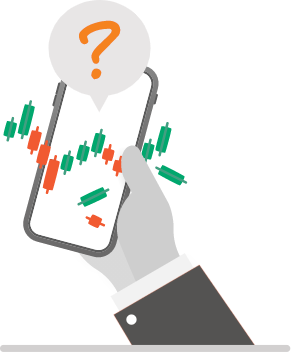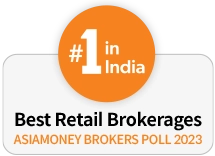- ZERO AMC for the first year**
- Dial-N-Trade at ZERO cost
- 100+ short-term recommendations per month
- 29 years of customer trust

What is Futures trading?
Futures are a type of Derivative instrument that’s traded in the market. Derivatives, which have no inherent value of their own, derive their value from changes in the price of other financial instruments, known as the underlying asset. There are mainly 4 types of underlying assets: stocks, indices, currency pairs, and commodities. A derivative's price follows the price of the underlying asset from which it derives its value.
Good-to-knows about Futures trading
- Traders who trade in the Futures market primarily want to take advantage of price fluctuations.
Alternatively, they aim to mitigate the risks associated with Commodity price fluctuations. - When buying a Futures contract, an investor makes a small up-front payment instead of the complete sum. The trader has now locked in the price of the underlying asset or commodity till the contract’s expiration date.
- In the F&O segment, the buyer has what is known as the “long” position; the seller has the “short” position.
- Being a derivative asset, the contract's price shifts from time to time as the underlying asset’s price varies, which affects the trader's profit or loss.
- In India, the BSE and NSE stock exchanges mediate in the F&O segment and keep an eye on each contract.

Trading in Futures market
Instead of buying or selling the actual Cash commodity, which is done with a stock, Futures are typically used to hedge Commodity price-fluctuation risks or to take advantage of price changes. Four basic types of assets are offered for Futures contracts: stocks, indices, currency pairs, and commodities. Hedgers and speculators are the two main players in Futures trading. Futures are used by hedgers to protect themselves from irrational or quick future price changes in the underlying Cash commodity. Hedgers are typically organisations or people who occasionally trade in the underlying Cash commodity.
Example of hedging with Futures
Futures can be used by corn producers to get a fixed price for selling their harvest. They lessen their risk and ensure they will get the predetermined price by doing this. The farmer would profit from the hedge if the price of corn fell, which would help to make up for any losses from selling the corn at the market. The hedging successfully locks in a fair market price because the gains and losses are balanced out.
Example of speculating with Futures
The second largest category of Futures players is “speculators”. Let’s see what they do.
Presume a Futures speculator named Vishwas expects the stock price of LMN Ltd. to increase in the coming months. He wants to make money from this opportunity. Instead of buying shares of LMN from the stock market, he buys LMN Futures with the company’s stocks as the underlying asset.
Vishwas has Rs 1 lakh to invest. Let’s assume that 1 LMN Futures contract is available at Rs 2,000. One contract contains 250 shares. So, the total value of the contract is Rs 5,00,000. Worry not, Vishwas does not have to pay the entire Rs 5 lakhs to buy an LMN Futures contract. He just needs to pay an initial margin, which is well below the Rs 1 lakh he has available to invest.
Let’s assume the initial margin he has to provide for this transaction is Rs 60,000. Calculate margin requirements with ease on the Mirae Asset Sharekhan Margin Calculator.
Vishwas takes ownership of 1 LMN Futures contract for Rs 60,000.
In a few weeks, by the time Vishwas’s LMN Future contract is close to expiry, his initial speculation has proven accurate and the price of the underlying asset, LMN Ltd.’s stock price, has risen from Rs 1,950 to Rs 2,400. Let’s see how he benefits. In this example, the price of LMN Futures contract has increased from Rs 2,000 to Rs 2,500. Vishwas’s buying price was Rs 2,000 and his selling price is Rs 2,500. So, he made Rs 500 per share. We know from earlier that one LMN Futures contract contains 250 shares, so his total profit is 500 X 250 = Rs 1,25,000!

More about Derivatives products
Both Futures and Options are classified as Derivatives.
Futures
Futures are agreements between two parties to trade (buy or sell) a certain asset at a defined price and at a predetermined future date.
Options
On the other hand, Options are contracts that grant the buyer a right rather than an obligation to carry out their end of the bargain.
There are two types of Options trading in India: Call Options and Put Options.
Call Options: With a Call Option, you have the ability to use your purchasing power (at the strike price) before the Options contract expires.
Put Options: A Put Option gives you the option to sell at the strike price before the Option expires.
Benefits of opening a Futures trading account
Benefits of opening a Futures trading account
-
Highly leveraged investments: Ideal to optimize your earnings
-
Market is very liquid: Quick orders and no dramatic fluctuations
-
Fewer charges: Execution costs and commissions are low
-
Quicker profits: Speculators can make money faster with Futures than in Equity
-
Great for diversification or hedging:
-
More efficient and fair markets:
As we’ve seen earlier, Futures are ideal for speculating, sometimes even better than other financial instruments. Although it might seem like it at first, Futures do not carry a higher level of risk than other market instruments like stocks, currencies or commodities.
When trading Futures, you should know that these are highly leveraged instruments and can be used to greatly increase your earnings. Futures and Options are used by hedgers to protect themselves from irrational or quick future price changes in the underlying Cash commodity. Market speculators use Futures & Options to make large profits in a short time span.

How to open a Futures trading account?
At Mirae Asset Sharekhan, it takes just 3 steps to open an equity trading account (also known as a Demat account). And once you have a Demat account, activating the Futures segment is seamless and easy. Let’s see the steps:
STEP 1
Fill in your basic personal details
STEP 2
Upload a few KYC documents (like PAN, Aadhaar, cancelled cheque) that are SEBI-mandated to open a Demat & Trading account
STEP 3
The Demat & Trading account is activated post verification
STEP 4
To activate Futures, Proof of Income is to be submitted, which can be done 100% online via the Mirae Asset Sharekhan app or website
Why invest in Futures trading through Mirae Asset Sharekhan
We’ve taken our F&O knowledge accumulated over 2 decades to craft Tools and Research methodologies that actually work!
Futures present unique opportunities for a market participant, and we’ve built an F&O ecosystem that delivers for you.
Short-term Trading Offerings
| Product Name | Segment | Suited for | Time Frame |
|---|---|---|---|
| CTFT | Futures/Cash | Short term traders who can carry the position overnight | Next trading session |
| Momentum Swing | Futures | Short term traders who trade on long & short side | 1-5 days |
Positional Trading Offerings
| Product Name | Segment | Suited for | Time Frame |
|---|---|---|---|
| Smart Chart | Futures | Positional traders who trade on long and short sides | 3-4 weeks |
Derivative trading FAQs
What is Futures Trading
Futures trading is a type of derivatives trading wherein contracts derive their value from underlying assets, such as stocks, indices, currency pairs, or commodities. Instead of paying the full price upfront, a trader can enter into an agreement to buy or sell an asset at a predetermined price on a future date.
Futures contracts are commonly used for speculation or hedging against price fluctuations. In India, these contracts are traded on exchanges like NSE and BSE under the Futures & Options segment.
What is the benefit of Futures trading?
Futures are ideal for speculating, sometimes even better than other financial instruments. Futures do not carry a higher level of risk than other market instruments like stocks, currencies or commodities. When trading Futures, you should know that these are highly leveraged instruments and can be used to greatly increase your earnings. Futures are used by hedgers to protect themselves from irrational or quick future price changes in the underlying Cash commodity. Market speculators use Futures to make large profits in a short time span.
Are Futures a type of Derivative?
Yes, Futures are a type of Derivative instrument that’s traded in the market, along with Options. Derivatives, which have no inherent value of their own, derive their value from changes in the price of other financial instruments, known as the underlying asset. There are mainly 4 types of underlying assets: stocks, indices, currency pairs, and commodities. A derivative's price follows the price of the underlying asset from which it derives its value.
What is F&O trading account?
To trade in Futures and Options, you need to open a Demat account with a stockbroker (like Sharekhan), and then activate the Derivatives segment. Click here to know how to activate the Derivatives segment on the Sharekhan app and website. As we’ve seen earlier, Futures are ideal for speculating, sometimes even better than other financial instruments. Although it might seem like it at first, Futures do not carry a higher level of risk than other market instruments like stocks, currencies or commodities.
When trading Futures, you should know that these are highly leveraged instruments and can be used to greatly increase your earnings. Futures are used by hedgers to protect themselves from irrational or quick future price changes in the underlying Cash commodity. Market speculators use Futures to make large profits in a short time span.
What are Futures?
Futures are a type of Derivative instrument that’s traded in the market. Derivatives, which have no inherent value of their own, derive their value from changes in the price of other financial instruments, known as the underlying asset. There are mainly 4 types of underlying assets: stocks, indices, currency pairs, and commodities. A derivative's price follows the price of the underlying asset from which it derives its value.


